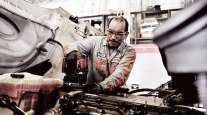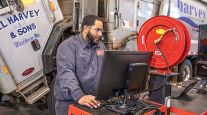Some DPFs Have Defects, Truck, Engine Makers Say
This story appears in the Sept. 27 print edition of Transport Topics.
RALEIGH, N.C. — Representatives of three major truck and engine makers candidly admitted to fleet maintenance directors meeting here that some performance results of diesel particulate filters have not worked out as well as originally anticipated.
DPFs, which reduce the emission of diesel particulate matter, have been standard equipment on U.S. and Canadian trucks built since Jan. 1, 2007, but the ceramic material in them has been cracking under the stress of operations — a defect that can generate the need for a new $3,500 part.
The DPF issue bubbled up at a “Fleet Talk” session Sept. 20 during the fall meeting of the Technology & Maintenance Council of American Trucking Associations. Speaking on the condition of anonymity, several maintenance managers expressed frustration about DPFs cracking early, with dissatisfaction spread among several manufacturers.
The next day, Steph Sabo, TMC’s immediate past chairman, asked manufacturers about the scrap rate of DPFs and the need for replacements.
“It’s higher than we’d like, but most of it has been warranty-related so far,” said Mark Spaseff, a vice president of Mack Trucks and Volvo Trucks North America.
Echoing Spaseff’s “higher than we’d like” phrasing were Vic Meloche, a manager for Detroit Diesel Corp., and Kevin Otto, a service director for Cummins Inc. Cummins and DDC rank Nos. 1 and 2, respectively, in North American heavy-duty truck engine sales.
DPFs were placed on trucks in response to the U.S. Environmental Protection Agency’s 2007 tightening of emissions standards. The filters enabled truck and engine makers to cut particulate matter emissions by 90% to 0.01 gram per brake horsepower-hour from the previous standard of 0.10 gram.
DDC’s Meloche said the top reason for DPF failures was fluid surge. If a radiator or other component containing fluid fails, the liquid goes through the truck, including the DPF, which treats gases post-combustion. The second reason he mentioned was difficulty in engineering a solution for a very complicated problem.
“We’re gaining experience in operations and we’ve made modifications [for the newer DPFs]. We’ve tweaked our strategies,” he said.
As an example, Meloche said a 2010 DPF in a Detroit Diesel will have two ceramic substrates, whereas the 2007 models have just one.
Otto said Cummins has studied the matter internally but declined further comment.
Spaseff also mentioned the difficulty of the task involved.
“It’s mostly because this is a new technology. There was no baseline for what’s out there,” he said.
Given that cracking can occur, the panel also offered suggestions for minimizing the event. DPFs, they said, need two types of cleaning: for particulate matter, soot, and for ash, a post-burning residue.
The soot is usually eliminated through filter regeneration, which can be passive, active while in motion, or an in-shop process in the most severe cases. Ash can be taken care of only in a maintenance shop, and failure to do so periodically can cause expensive cracking.
During the meeting, TMC also addressed auxiliary power units, which provide in-cab heating, cooling and electricity for appliances. There was a broad endorsement of the goal of APUs providing these necessities when the driver is resting in his or her sleeper without running the truck’s main engine.
However, Kirk Altrichter, chairman of TMC’s cab and controls study group, outlined two major problems. APUs that have a small diesel engine for heating and other purposes could lead to a nightmare scenario, especially in California: a truck with three DPFs, one each for the truck’s main engine, the APU and a refrigerated unit if the truck is hauling perishables.
“That’s a lot,” said Altrichter, the vice president of maintenance for truckload carrier Gordon Trucking, Pacific, Wash. Altrichter said Gordon has used APUs for six years and that the payback period for the devices is about 18 months.
Many APUs are all-electric now and use a bank of rechargeable batteries. They have no diesel emissions at all, but batteries have their own problems: limited running time and limited surge power.
Altrichter said dorm-style refrigerators are common in sleepers because they are inexpensive, but they use too much power. He also said he has seen larger microwave ovens, desktop computers rather than laptops and, in one case, a 40-inch flat-screen television.
Too many appliances can eat up all of a battery’s reserves, leaving no amperage to start the truck. Altrichter and others at the session recommended a dedicated battery for starting purposes only.
Terry Zeigler of Bergstrom Inc., which makes APUs, recommended a frugal approach to their usage, suggesting drivers draw an in-cab curtain separating the driving area from the sleeper, so the APU can cool a more limited area in the summer.




